Source: Coinbase; Compiled by Wuzhu, Golden Finance
Summary:
The 2024 Bitcoin halving took effect on April 20, reducing the fixed block reward from 6.25 BTC to 3.125 BTC.
We believe that the increase in rune-driven transaction fees and the rise in BTC in the first quarter of 2024 may support continued growth in network computing power for some time at current price levels.
At the same time, the Bitcoin Layer 2 (L2) ecosystem continues to expand, with plans to launch multiple mainnets in the coming months. While we believe there are still many technical and transparency challenges, this could be a game changer for Bitcoin.
Market Insights
The 2024 Bitcoin halving took effect on April 20, reducing the fixed block reward from 6.25 BTC to 3.125 BTC and reducing Bitcoin’s daily inflation from $60 million to $30 million (67,000 BTC). At the same time, the launch of Runes on Bitcoin (an alternative to Ordinals and the BRC-20 protocol) led to a spike in block space demand. On April 20, a total of 1,257 BTC was spent in transaction fees, second only to the 1,495 BTC spent on December 22, 2017. In USD terms, total transaction fees hit an all-time high of $81 million on April 20.
While there is some uncertainty around miner profitability and sustainable hashrate growth due to the block reward reduction, we believe the relative increase in variable transaction fees (combined with BTC gains in Q1 2024) is likely to support continued growth in network hashrate in the short to medium term. Post-halving, transaction fees have accounted for 35-45% of total miner revenue, initially surging to 75% on day one. This mirrors previous Ordinals fee surges seen in May 2023 and December 2023.
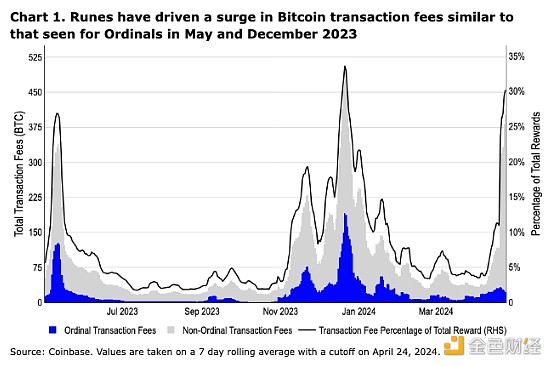
Since our January 30, 2024 report on Bitcoin miners (published at BTC $43,000), BTC has appreciated by ~50%. Meanwhile, Bitcoin’s network hash rate has only grown by ~10% (from ~560EH/s to ~630EH/s). Our calculations show that the current network hash rate is ~630 EH/s, which is only 11% of the network’s theoretical maximum hash rate and well below the 25% soft cap observed during the last halving and the recent bear market.
Even if rune-driven activity subsides and transaction fees return to 5% of miners’ total revenue (as they did 1-2 months after the previous Ordinals-induced demand surge), the network would still only be able to achieve around 17% of its theoretical maximum hashrate at current Bitcoin prices. This suggests to us that, all else being equal, miners can continue to increase hashrate and profitably do so. In fact, the current most advanced miner, Bitmain’s Antminer S21, is already sold out, and the next-generation machine, the S21 Pro (which further increases mining efficiency from 17.5 J/TH to 15 J/TH), is scheduled to ship in Q3 2024.
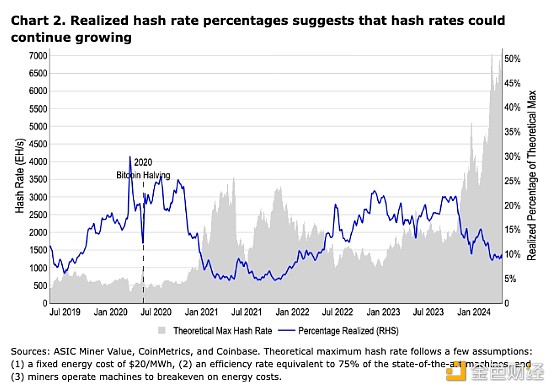
More broadly, the Bitcoin Layer 2 (L2) ecosystem is also continuing to expand, with multiple mainnet launches expected in the coming months. This could be another source of demand for Bitcoin transactions, especially if Runes or BRC-20s minted on the base layer become widely used across these L2s. It is unclear how assets minted on one Bitcoin L2 would be canonically bridged to another without leveraging the native BTC asset. In the case of Ethereum, many of the tokens on its L2 (from stablecoins to DeFi governance tokens) were minted on the Ethereum base layer before the bridge. The governance and core functionality of major DeFi protocols such as Uniswap, Maker, and Aave also still appear on the Ethereum mainnet.
That said, Bitcoin lacks the same foundational smart contract functionality as Ethereum, so its ecosystem may not be similarly anchored to the base layer. This may cause liquidity between Bitcoin L2 to be more fragmented than liquidity on Ethereum L2. Bitcoin's lack of smart contracts (or sufficiently flexible OP code) may also have broader implications for the security implementation of its L2. With few exceptions, core Rollup properties (such as the ability to force the inclusion of transactions through the base layer) appear to be impossible under many chain architectures labeled as Bitcoin L2.
In fact, the relatively loose use of the term "L2" in the Bitcoin ecosystem means that many networks labeled L2 are actually closer to what the Ethereum community generally understands as sidechains. This broad labeling may make it more challenging for users to navigate the various security trade-offs between chains, especially because there is currently a lack of community-driven sources of transparency, such as L2BEAT for Bitcoin L2. Bridges have historically been the target of the largest hacks in the space, and the relative nascence of Bitcoin L2 designs means that bridges are far from a risk-free endeavor.
However, despite the technical challenges, we believe that Bitcoin L2 represents an exciting and critical development in the space at a time when Lightning Network capacity and WBTC levels on Ethereum have stagnated (see Figure 3). Historically, BTC holders have been largely sidelined when new use cases and other innovations have emerged on other chains, with WBTC being the primary access vector for DeFi and Lightning Network being the primary means of low-fee transactions.
The emergence and enthusiasm for Ordinals, BRC-20, and now Runes shows that there is indeed significant demand from BTC holders to do more with BTC on-chain than just “hold” it. We believe that the broad interest in these solutions reflects the Bitcoin community’s eagerness to leverage its holdings as part of a more complete computing environment. Importantly, these developments could further open up DeFi and other blockchain advancements to the largest source of on-chain capital: Bitcoin. That said, we expect it will take several more months for a clear long-term leader to emerge as security and design tradeoffs become clearer.
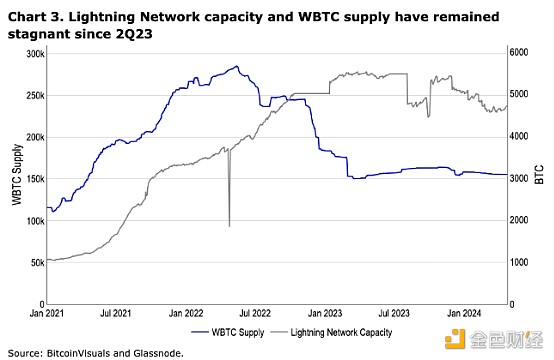
Crypto and Traditional Finance
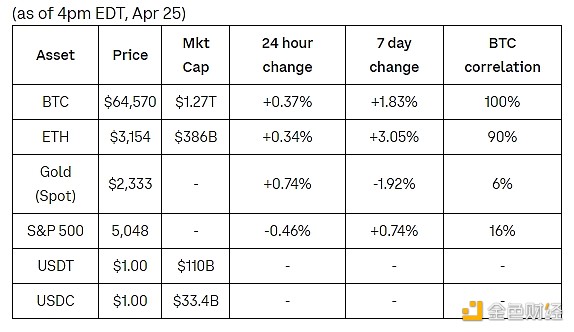

Coinbase Insights
The much-anticipated Bitcoin halving had little impact on price action. We saw some de-risking of Bitcoin positions ahead of the halving event, but the feared sell-off on the news never materialized. We believe this may be because expectations have been cleared out. Funding rates have fallen to near their lowest levels year-to-date, indicating low long positioning. ETF flows have also slowed, with just $28 million flowing into the product over the past week. Traders are watching to see if the market can sustain current levels on lower volumes. If it can, this could be seen as a constructive sign as we head into late spring and early summer.
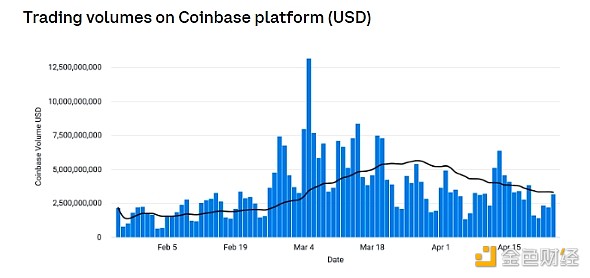
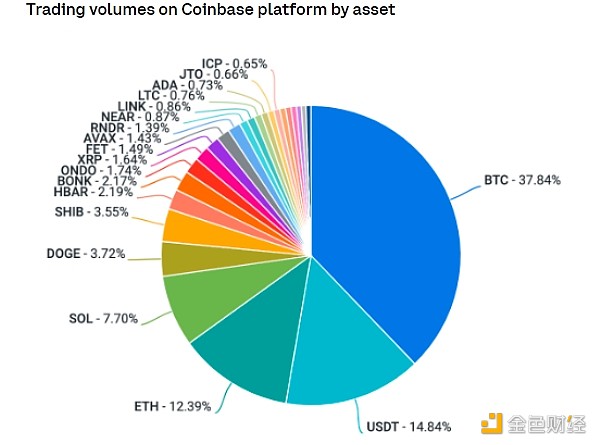
Financing interest rate
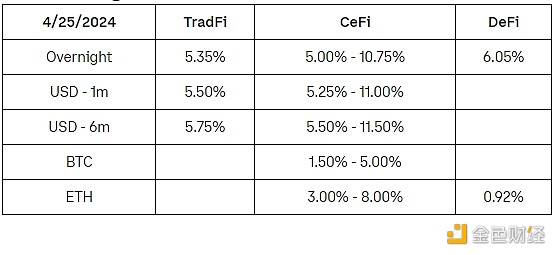
 JinseFinance
JinseFinance








